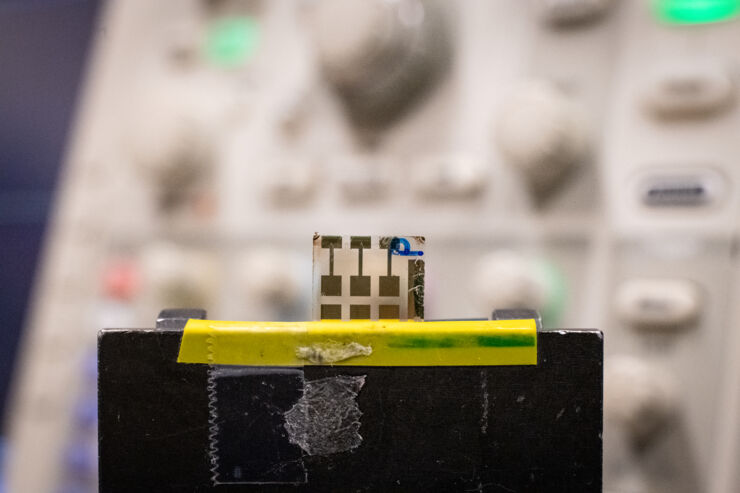Apr 6 2020
Scientists at Linköping University collaborated with colleagues from China to design a small unit that is both an optical receiver and a transmitter.
 The perovskite that comprises a light-emitting diode and that at the same time is an excellent photodetector. Image Credit: Magnus Johansson.
The perovskite that comprises a light-emitting diode and that at the same time is an excellent photodetector. Image Credit: Magnus Johansson.
This is highly significant for the miniaturisation of optoelectronic systems.
Feng Gao, Professor and Head of Research, Division of Biomolecular and Organic Electronics, Linköping University
At Linköping University, Chunxiong Bao, a postdoc, types in a sentence on a computer screen, and the exact sentence appears on the nearby screen without any delay, optically transmitted from one diode to another. The diode has been developed from perovskite, one of a huge class of materials characterized by their unique crystal structure.
Perovskites include halogen and metal and have been found to be versatile semiconductors that are cost-efficient and simple to manufacture. In addition, they exhibit the useful property of both emitting and detecting light.
At Linköping University, scientists collaborated with colleagues from China and have designed a diode that can be directed in two directions. The diode can receive optical signals and can simply transmit them as well.
This implies that photographs and text can be wirelessly transmitted to and fro between two units, where both the units are identical. The transfer occurs so quickly that it is felt as if it occurs in real time.
LED and Photodetector
In the autumn of 2018, Chunxiong Bao identified the right perovskite to develop a photodetector that exhibits longer lifetime and higher performance. This study featured as an article in Advanced Materials. The building of light-emitting diodes from perovskites has also advanced very fast.
Last year at Linköping University, Weidong Xu, a postdoc, designed a perovskite light-emitting diode that had an efficiency of 21%. This is considered the best in the world and the outcomes were published in the Nature Photonics journal.
The researchers have now developed a perovskite that includes a light-emitting diode and is an outstanding photodetector at the same time.
Optical communication of all types needs reliable and quick photodetectors—devices that trap light and transform it into an electrical signal. The present optical communication systems make use of photodetectors that are created from materials like indium gallium arsenide and silicon. These materials are expensive and cannot be utilized in applications that need adaptability, large surfaces, or low weight.
In order to demonstrate the potential of our diode with double function, we have built a monolithic sensor that detects heart beats in real time, and an optical, bidirectional communication system.
Chunxiong Bao, Researcher, Division of Biomolecular and Organic Electronics, Linköping University
Unique Opportunities
This small unit is capable of receiving and transmitting optical signals, offering a distinctive opportunity to decrease and simplify the functionality of the existing optical systems, specifically because it can also be combined with conventional electronic circuits.
We have managed to integrate optical signal transmission and reception into one circuit, something that makes it possible to transmit optical signals in both directions between two identical circuits. This is valuable in the field of miniaturised and integrated optoelectronics.
Feng Gao, Professor and Head of Research, Division of Biomolecular and Organic Electronics, Linköping University
The study outcomes have been reported in the Nature Electronics journal.